Goa is a place of interests hidden in every nook of the legendary structures. Each edifice has a story to tell of its own built, with extraordinariness and grandness emoting out from the sinews of enormous stones, standing the test of time and ravages of nature.
Kaullem (4-6 km SW of Ponda town)
The Shantadurga Temple at Kaullem is as good a site as any to begin the journey into Hindu Goa. The shrine is believed to have been built in 1728, during the reign of the Maratha ruler, Shahu Raje of Satara. The temple bizarrely is located in Kaullem`s Maharvada area - the pocket in which people who were once looked at as `untouchables` lived. The residents are believed to have allowed the shrine`s construction in return for the benefit of worshipping in it every year. The tradition continues on Magh Suddha Shastra, when community members are given saris, coconuts, rice and money.
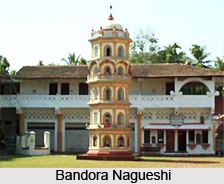 Bandora (4 km NW of Ponda)
Bandora (4 km NW of Ponda)
The temple of Nagueshi, which reveres Shiva as the Lord of Snakes, in Bandora, is situated next to the palace of the king of Sonda. The tempting temple tank provides a shelter for schoolboy swimmers on sultry afternoons, and an inscription here memorialises a contribution made in 1413 by Mayeen Shenvi Wagle, an official in the administration of the Vijayanagara Kingdom. The tank is looked upon as the most hallowed of Goa`s temple tanks. An arresting Nandi Bull sits on the portico, while the sabha mandapa (assembly hall) is lined with a gallery that contains woodcarvings portraying scenes from the Ramayana.
Velinga (4-5 km NW of Ponda)
The 16th century Lakshmi-Narasimha Temple in Velinga is a treasure in yellow, green and cream. Unlike many other temples in the area, this shrine does not have any repulsive concrete annexes. A spring-fed tank stands in front of the temple, placed at the foot of a luxuriant hill. Narasimha, the 5th incarnation of Vishnu is worshipped here.
The temple timings are from 7.30 a.m. - 8.30 p.m.
Priol (9 km N of Ponda)
The most significant temple in Ponda is the Mangesh Temple in Priol. But several considerable shrines lie between the Shantadurga and Mangesh temples. The deepastambh of the Ramnath Temple, near the Shantadurga Temple, possesses friezes of Vivekananda, Meera-bai and Tukaram, among others along the bottom, and an exuberant silver screen at the entryway of the garbha griha. Ramnath is the incarnation of Shiva that Ram had prayed to, before departing to rescue his wife from Lanka. Therefore the idol here is worshipped both by Shaivites and Vaishnavites (since Ram himself is an incarnation of Vishnu). The deity was repositioned to its present home from Loutolim in Salcete in 1566, to save it from demolition by the Portuguese. The temple was repaired in 1905.
 Mhadrol (7 km NW of Ponda)
Mhadrol (7 km NW of Ponda)
The Mahalsa Temple in Mhadrol is immensely popular, because the goddess is thought to satisfy the wishes of her devotees. She is worshipped by people of every caste and is the incarnation of Lord Vishnu`s consort, Lakshmi and Shiva`s wife, Parvati. A gigantic brass deepastatnbh overshadows the courtyard, together with a ganidastambh, flying a flag. The door leading to the inner shrine is beautified with patterns of creepers. Northeast to Mhadrol is the Anantha Temple at Savoi Verem, the only Vishnu temple in Goa. The deity is believed to have powers to exorcise charms. Girded on all sides by water, it calls for a pretty picture.
Marcela (16 km N of Ponda)
Marcela is home to the new Shantadurga Velkarin and the Devki-Krishna temples. The latter is believed to be the only temple in which Krishna and his mother are portrayed together. The idol was transported from the island of Charao during the time of Portuguese terror. "When Vasco da Gama visited Charao, he saw the idol through the main doorway and saluted, thinking it was Mother Mary with baby Jesus," A.R.S. Dhume writes in his Cultural History of Goa. But when the significance of the statue was explained to him, the explorer was "very much annoyed", Dhume recounts.
The temple timings are from 7.30 a.m. - 8.30 p.m.
Carambolirn-Brahrna (7 km north of Valpoi)
Another widespread shrine at Carambolim-Brahma, the headquarters of Satari Ta-luka, that may be significant a trip just for its oddity, is the Brahmadeva Temple - one of the two Indian shrines dedicated to the creator- Brahma (the other is in Pushkar, Rajasthan). It is a pretty drive to areca nut plantations, but there is not much to be amazed at about the remodelled pink building. Brought here from Old Goa, the standing idol has four heads, each facing a cardinal point.
Temple timings are from sunrise to sunset.
Sanquelim (7 km SE of Bicholim)
On the way back, one can consider meandering past the Datta Mandir in Sanquelim, a blue lay of serenity, built in 1882. The central hall is still illuminated with oil lamps, reflections of which spark on the smoothened wooden ceiling. The sanctum has a white marble idol of Lord Dattatreya, an amalgamation of all the three members of the Hindu trinity. The Vithal Temple closeby was erected in 1410, with an allowance from the Rane family, who live in a sprawling home next door. The clans were known for the series of rebellions they crusaded against the Portuguese between 1755 and 1912.
Datta Mandir is open from sunrise to sunset.
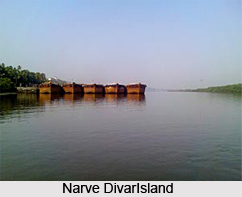 Narve (6 km SW of Bicholim Town)
Narve (6 km SW of Bicholim Town)
The most popular temple in Bicholim by far is the 12th century Saptakoteshwar Temple in Narve, which was transposed from the closeby Divar Island - so that it would be protected from the Portuguese. Material from the temple was integrated into Divar`s Church of Our Lady of Compassion, and the decoration on the ceiling of the chapel in the walled cemetery next-door hints that the building was an erstwhile Hindu shrine.
Arvalem (9 km SE of Bicholim)
Bicholim is also home to the Arvalem Caves, a set of Shaivite chambers that possibly were hewn out of laterite rock by Buddhist monks before Shiva lingas were placed in some of them. They have been dated back to the first quarter of the 5th century, based on two inscriptions in the caves, and by the style of the recessed panel on top of the facade. Details are difficult to witness, because one needs to peer into the dark caverns, but an elaborated sign erected by the ASI guides one precisely what to look for. The closeby Rudreshwar Temple, encircled by areca groves, has an enormous tank in the backyard, fertilised by a waterfall. The lingam sits on a gilded platform, while the rath in the courtyard is a vibrant vehicle with wooden horses to boost it along.
Panaji (9 km W of Old Goa)
Panaji was adjudged Goa`s capital only in 1843, though it began to flourish in 1759, when an epidemic in Old Goa impelled the Portuguese viceroy to reallocate his residence to the village of fishermen and artisans further downstream on the banks of the Mandovi. It is small enough to trudge on foot, and exceedingly during the evening. Among the most remarkable buildings here is the Idalco Palace, the former palace of Adil Shah, now the State Secretariat. Plans are underway to refurbish the structure into a pre-Portuguese era museum.
Paroda (11 km SE of Margao)
Also in Salcete is the temple of Chandreshwar-Bhutnath, roosted atop a hill in Paroda that offers a sensational view of the surroundings. The temple, consecrated to the moon god, has been erected in such a way that it permits the light to fall on the lingam on a full-moon night. The god was worshipped by the Bhojas, and later, by the Kadambas. The Bhutnath Temple next door has a menhir that is worshipped as a deity. Scribbling on a boulder in the courtyard, however horribly deceives the cosmopolitan approach of the locals.
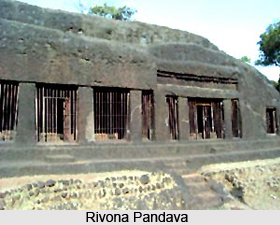 Rivona (25 km S of Sanguem)
Rivona (25 km S of Sanguem)
The (Damodar Temple in Zambaulimpon the way to Rivona, has been remodelled to ensure that any shadows of spell or taste have been exorcised, but the idol of Shiva is believed to be numerous centuries old. One can make a short halt on the long drive to Rivona to see the caves that the locals refer to as the Pandava Caves, which are in reality Buddhist cells dating back to the 7th century. There are two sets of caves at Motvaddo in Rivona, one on both sides of the main road. Uncoverings at the site comprise tile fragments, shreds of pottery, iron nails and numerous smelting pipes encrusted with iron.
Usegalimal (16-18 km S of Rivona)
Farther down a soil road past the Pirla iron ore mine is the 5,000-sq. m. complex of carvings cut into the bed of the Kushavati River at Usgalimal. Identified in 1993, the site goes back to the Mesolithic period and is within 8,000 and 9,000 years old.
The Christian Goa
Christian Goa is largely a UNESCO World Heritage Site. All the churches here are splendid illustrations of late Renaissance, early baroque architecture, which succeed the extravagant, complex tribhuvan tiwahi Portuguese style of ornamentation, called Manueline (after the Portuguese king Dom Manuel). The exteriors of the churches look weather-beaten and hard - they are mostly manufactured of red laterite stone, the equivalent stone that gives Goa its rich red soil when it erodes. However, their interiors are magnificient fantasias of gold leaf and colour. In addition, their sheer enormity is sure to take one`s breath away.
Old Goa
A good place to start is the Quay of the Viceroys, now the jetty on the River Mandovi. This is an agreeable place where a hushed river swishes against weather-beaten stones. As one turns their back to the river the Arch of the Viceroys stands erect in front, rising above what was once the Rua Direita or the main access of the city. It is little more than a grimed track currently. One needs to use their vision to reconstruct the busy metropolis that once hustled, bought and merchandised by the river.
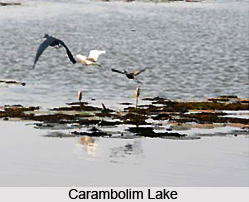 Carambolim (12 km E of Panaji)
Carambolim (12 km E of Panaji)
This vast shallow lake at Carambolim (pronounced `Karmali`) - which looks unexpectedly like a wet field after a downpour - is Goa`s finest bird sanctuary. The Carambolim Lake Bird Sanctuary draws thousands of migratory water birds and waders during the winter. It also has a reasonable range of native species. The lake adjoins the Karmali Railway Station, though it is better neared from the other side. A road goes to the right, approximately 2 km towards Ponda from Old Goa, opposite the Corlim Industrial Estate. After nearly a kilometre, the lake falls on the right.
Panaji
Panaji offers the best perceptiveness into the ways of Catholic Goa. Panaji is probably Goa`s prettiest place. Even though builders are busy trying to mutilate the city`s low skyline, Panaji`s public buildings are still mostly elegant Portuguese edifices.
Pilar (11 km SE of Panaji)
There are two means to reach Pilar. After sightseeing in Old Goa, one can take the Carambolim Road past Karmali Station and Neura to Pilar, which surfaces on the right just before the road from Carambolim meets National Highway 17. Alternatively, one can drive down National Highway 17 from Panaji till Goa Velha, and then turn left to Pilar.
Pilar Seminary is a spiritual and educational institute and a pilgrimage centre for devotees of one of Goa`s saints-in-waiting, the august Father Agnelo. It houses a gallery devoted to artefacts from the former capital of the Kadambas, Gopakapattana. These include Stone Age tools, Roman coins, specific terracotta objects that display Roman influence, a dainty Ganesh idol and gold coins inscribed with the name of Jayakeshi II.
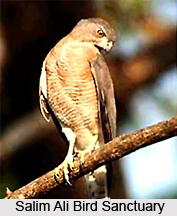 North of the Pilar Seminary is the Church of St. Anna at Talaulim. It is consecrated to the maternal grandmother of Jesus Christ, mother of the Virgin Mary, St. Anne. It has an outstanding frontage area that rises up five storeys with Saint Anne as the focal attraction. It was constructed in 1695 and utilises regional motifs. One can stand and admire the exquisite lotuses, palm leaves and myrobalans in the carving. The walls, it is alleged, are hollow, so that people might walk through them to confession in private.
North of the Pilar Seminary is the Church of St. Anna at Talaulim. It is consecrated to the maternal grandmother of Jesus Christ, mother of the Virgin Mary, St. Anne. It has an outstanding frontage area that rises up five storeys with Saint Anne as the focal attraction. It was constructed in 1695 and utilises regional motifs. One can stand and admire the exquisite lotuses, palm leaves and myrobalans in the carving. The walls, it is alleged, are hollow, so that people might walk through them to confession in private.
Chorao Island (4 km NE of Panaji)
To reach Chorao, one requires to take a ferry from the Panaji Jetty. A number of boatmen await with boats for transit. Chorao is also joined by ferry to Ribandar, on the Panaji-Old Goa Highway, and by ferry to Pomburpa near Mapusa in Bardez, though Pomburpa is off the tourist track and hence pretty inconvenient. Either way, it is best to reach Chorao early to have a look at the birds before heading for the church.
The Chapel of St. Jerome in Chorao is a spherical structure of laterite plastered with lime and surmounted with a domed roof. There is a pillared verandah around it. The chapel is probably the only prehistoric chapel in Goa with a spherical plan.
At the western tip of the island of Chorao is the Salim Ali Bird Sanctuary. An assortment of migratory birds visits the area. The sanctuary can be reached on foot after crossing over on the Ribandar-Chorao ferry. It is best to go for a boat tour on a canoe fitted with an outboard motor. The sanctuary can be toured anytime with the authorisation of the Forest Range Officer or Divisional Officer.



















